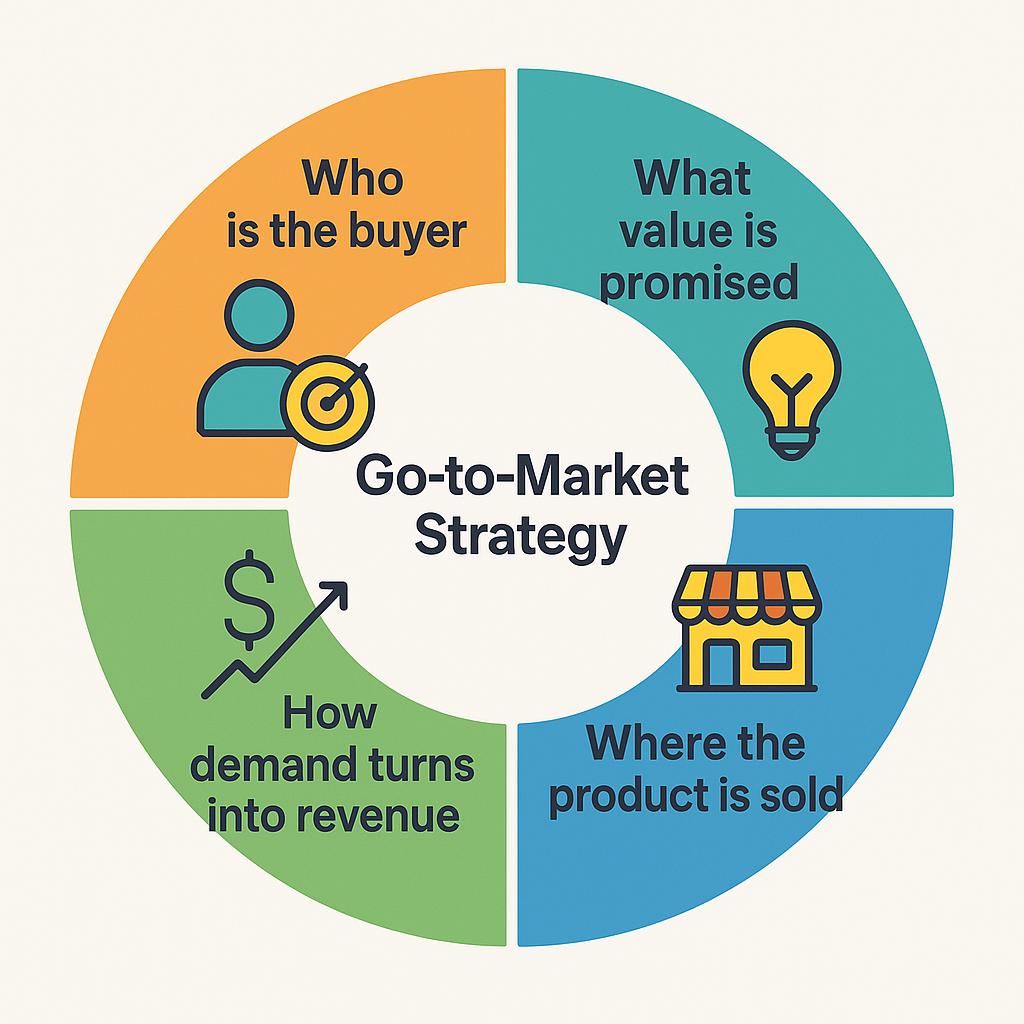If someone wants a clear go-to-market strategy example, this guide lays out a practical, step-by-step model that you can quickly adapt.
It follows an imaginative pet-focused smart home startup and turns strategy jargon into day-to-day actions.
The approach is simple, constructive, and fast to implement. It leans on proven frameworks and concrete tactics that any marketing team can apply with confidence.
What Is a Go-to-Market Strategy?
A go-to-market strategy (GTM) is the plan that connects a product to its buyers through the right segment, message, channels, and revenue model.
It answers four questions: who is the buyer, what value is promised, where the product is sold, and how demand turns into revenue.

It differs from general marketing strategy.
Marketing guides the brand over time, while GTM focuses on the path to adoption for a specific offer.
Therefore, a GTM plan typically includes:
- Focused audience
- Positioning statement
- Pricing and packaging
- Channel mix
- Launch calendar.
For early-stage teams, GTM also acts as a prioritization filter. It helps kill nice-to-have ideas and concentrate on what moves the needle first (to extend the plan into ongoing growth work, see practical playbooks on marketing for startups).
Meet the Business: PawSense
PawSense creates smart home devices built for households with pets.
The product suite includes a smart camera with a built-in treat dispenser, an automated feeder, and an air sensor that flags pet dander, humidity issues, or harmful fumes.
The target audience spans pet-owning households, especially millennial and Gen Z urban dwellers, families with pets, and busy professionals. They want peace of mind and healthier homes. They also care about simple setup and fair pricing.
The company’s mission is straightforward. It wants to reduce pet stress, improve indoor air quality, and make daily routines easier with thoughtful automation.
Market Research & Insights
Before a go-to-market strategy, market research provides a clear understanding of the audience, competitors, and opportunities
The research starts with three streams: buyer insight, problem validation, and category mapping.
First, buyer insight. Pet ownership is high in the United States, and spending continues to shift toward health, safety, and enrichment. The American Pet Products Association offers useful context on ownership trends and categories.
Second, problem validation. Interviews and diary studies confirm core jobs to be done. Typical jobs include monitoring a pet while away, sticking to feeding schedules, and keeping the home breathable for family members who are sensitive to dander.
Third, category mapping. Competing products include general smart cameras, connected feeders, and indoor air monitors. Yet many are built for general use, not pets. That creates room for integration, simplified onboarding, and specialized alerts.
Insights summary:
- Millennials and Gen Z want automation that saves time and reduces worry.
- Parents want clear health benefits for pets and kids.
- Renters prefer easy installation, flexible pricing, and portable hardware.
- All segments expect transparent data handling and quick support.
Go-to-Market Strategy Example: Step by Step
1. Positioning
Positioning is the process of defining how a product is suited to meet the needs of its target audience compared to competitors. It clarifies who the product is for, what core value it delivers, and why it stands out in the marketplace.
A positioning statement usually lives on a product page.
Positioning statement template:
For pet-owning households who need calmer, safer routines, PawSense is a smart-home system that manages feeding, monitoring, and air quality in one app. Unlike general-purpose devices, PawSense offers pet-specific insights, multi-device sync, and fast setup.
Positioning is built around message pillars that you determine in advance. In our case, those are:
- Peace of mind while away
- Healthier home air for pets and people
- Routine made simple with automation
Each pillar is backed by proof points:
- Unified dashboard for feeder, camera, and air sensor
- Smart alerts tuned to pet behavior and particles
- Guided setup that finishes in minutes
Copy example for product page could look like this:
- Headline: “Healthy routines for happier pets”
- Subhead: “Automated feeding, pet-first monitoring, and air quality alerts in one place”
- Social proof: Short quotes from beta users plus rating snapshots
2. Pricing Strategy
Pricing should reflect perceived value, switching costs, and the reality of household budgets.
It also needs an entry point for trial and a bundle that rewards full-system adoption.
For our imaginative business, the pricing structure could look like this:
| Tier | What they get | Target buyer | Price idea |
|---|---|---|---|
| Starter Camera | Camera + treat dispenser | First-time smart-home buyers | $129 |
| Feeder Solo | Automated feeder + app | Routine-focused owners | $149 |
| Air Sensor | Air monitor + alerts | Health-conscious homes | $99 |
| Home Pack | Camera + Feeder + Air Sensor | Multi-pet or family homes | $349 |
| PawSense Plus | App features, multi-device sync, advanced alerts, 30-day video history | Power users | $6.99 per month |
Practical levers:
- Anchoring: Show Home Pack value by listing individual prices and savings.
- Seasonal promos: Offer limited-time kit discounts to align with adoption spikes like new pet purchases.
- Subscription clarity: Spell out benefits, trial length, and renewal terms with zero surprises.
3. Distribution Channels
Distribution channels are important component of any go-to-market strategy, as they determine how a product reaches its target customers.
Start with direct-to-consumer, then layer marketplaces and selective retail as reviews grow.
Primary options with trade-offs:
- Direct website: highest control and better margins, but requires strong acquisition.
- Amazon: large reach and trusted checkout, yet fees and review dynamics.
- Pet specialty retailers: targeted foot traffic and staff recommendations, but slower onboarding.
- Veterinary partners: high trust for health-related products, yet longer partner cycles.
Operational notes:
- Use a shared inventory view to prevent stockouts.
- Keep packaging retail-ready from day one.
- Add QR codes inside the box to drive app activation and onboarding completion.
4. Marketing & Awareness
Marketing is another critical elements of our go-to-market strategy example, as it drive product visibility and credibility early in the adoption cycle.
The marketing plan mixes search, social, creator partnerships, and PR. It favors content that educates and reduces anxiety. It looks like this:
SEO and content:
- Build a topic map on pet wellness, feeding routines, and indoor air quality
- Ship product pages with crisp titles and refined meta descriptions that promise a clear outcome.
- Publish setup guides, quick wins, and troubleshooting posts. Each should include a short video and a printable checklist.
Social and creators:
- Short-form videos that show the treat dispenser in action, feeder schedules, and real-time alerts.
- Co-create content with pet trainers and vets.
- To scale creative volume without losing quality, see practical ways to use AI in social media content creation.
Public relations:
- Target pet health, smart home, and family lifestyle outlets.
- Offer a data-backed pitch on indoor air and pet well-being.
- Maintain a concise press kit with specs, photos, and reviewer FAQs.
5. Sales & Customer Acquisition
This step is about turning interested prospects into paying, engaged customers. It’s like the “last mile” of GTM strategy.
Define a simple funnel: step-by-step path a customer takes from first seeing our product to fully using it. It has three checkpoints:
- Viewed product page – they check out the product online.
- Added to cart – they’re interested enough to commit.
- Activated device – they actually start using the product (for PawSense, this could mean connecting the camera/feeder).
Key metrics – measure success at each stage:
- CAC (Customer Acquisition Cost) target by channel – How much it costs to get a customer from each channel (Instagram, ads, email, etc.).
- Conversion to checkout and activation – Percentage of people who go from viewing the page → adding to cart → activating the product.
- 30-day retention and referral rate – Are customers still using the product after a month? Are they referring friends?
Conversion tactics – practical actions to get more people through the funnel:
- Cart recovery emails – Remind people who didn’t finish checkout, maybe with a short video or discount.
- Chat support on high-intent pages – Help visitors who are about to buy but have questions.
- Referral credits – Reward customers for referring friends after activating their device.
Measurement – track everything so you know what works
- Weekly funnel review – Check metrics regularly and assign someone to own each one.
- Dashboards – Keep a simple view of spend, revenue, and retention by cohort.
- Social channels – Align reporting with realistic KPIs and use automation tools to track performance.
Launch Execution
A launch plan creates internal checkpoints for security and quality.
Here’s a 90-day blueprint:
Weeks 1 to 3, Prep
- Finalize positioning, messaging, and pricing.
- Complete device QA, mobile app polish, and privacy review against internal checklists.
- Produce essential assets and page copy.
Weeks 4 to 6, Beta
- Invite 100 to 300 targeted households across segments.
- Collect setup time, alert accuracy, and support ticket stats.
- Update the onboarding flow and FAQs based on top friction points.
Weeks 7 to 9, Soft launch
- Release to email waitlist and retargeting audiences.
- Launch top three content pieces, two creator partnerships, and one PR pitch.
- Monitor app crashes, activation rate, and first-week retention.
Weeks 10 to 12, Full launch
- Expand to marketplace listings and selected retail partners.
- Scale paid search and social creatives with best-performing hooks.
- Complete a security pass using the OWASP IoT Top 10 to maintain trust post-launch.
Summary
We showed you a concrete go-to-market strategy example for a made-up pet-focused smart home startup.
The example walks through research, positioning, pricing, channels, marketing, sales, and a clear 90‑day rollout. It mixes qualitative insights with measurable targets.
You can copy the structure, then adjust the tactics to match your goals and constraints.
It’s easier than ever to manage your marketing activities with tools like Stryng, an all-in-one AI-powered content marketing platform. Try it free today, or connect with our team and let us run it for you.
Frequently Asked Questions
Q1: How is a GTM strategy different from a product launch plan?
A: A GTM strategy defines audience, value, channels, and revenue mechanics. A launch plan schedules the work and assigns owners. The two are linked, but they serve different purposes.
Q2: What is the right timeline for a launch execution?
A: Many consumer hardware teams run a 90-day plan after a closed beta. Some products need more time for certification or retail onboarding. The timing should follow readiness gates, not wishful thinking.
Q3: What should be the first channel to test?
A: Direct website is usually first, because it allows faster learning and cleaner data. Marketplaces and retail can follow once reviews and operations are stable.
Q4: How should success be measured in the first quarter?
A: Track acquisition cost, conversion to activation, and 30-day retention. Also review support tickets by category. Those signals show product-market fit risks early.
Q5: Do subscriptions make sense?
A: Yes, if the subscription delivers clear ongoing value. It should be optional, transparent, and easy to cancel.
Q6: Is this GTM framework useful for different product categories?
A: It is adaptable to many consumer products that mix hardware and software. The core pieces stay the same, yet the content and channels will change with the audience.



